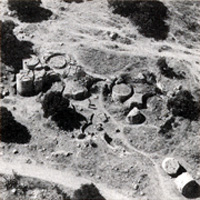
Cusa quarries
The International Carlo Scarpa Prize for Gardens
X Annual Award, 1999
The Jury of the International Carlo Scarpa Prize for Gardens has unanimously decided to award the tenth Prize to the Cusa quarries, which for over twenty-four centuries, suspended in time, has preserved the materials and the skills that gave rise to the Temples of Selinunte.
It is a place where nature and history engage in intense dialogue. A gash twisting for two kilometres through the Sicilian countryside, south-west of Campobello di Mazara. This was where the blocks of calcarenite were cut from the rock face. Here they were bound to wheels with techniques that are still not thoroughly understood. And from here, semi-dressed, they were transported the thirteen kilometres to the site of the temples along a route that we still know only in part.
No more than a few metres deep, this vein of rock scores a rift through the countryside. From the upper part fields slope south towards the sea. From the bottom, olive groves rise north towards Castelvetrano and the valley of the River Modione. Fixed in time, the various phases in the extraction and dressing of the stone are clearly visible at the quarry face. Enormous cylindrical shafts lie strewn around. Other blocks lie abandoned not far off, among the olive trees and along the road to Selinunte.
Everything tells a story: how the stone was quarried and worked, the slave-like conditions in which the labourers must have toiled, the beauty of the stone itself, the sudden dramatic interruption one day in 409 B.C., with the arrival of the Carthaginian army at one of the crucial moments for the geo-political equilibrium of the Mediterranean.
The Cusa quarries embody the shape of an event. They offer visible, direct evidence of how overwhelming such an event can be; so immediate and telling an impact that archaeological data and the place itself demand to be treated as more than picturesque ruins.
The site is therefore a unique repository of natural forms and historical memory, whose identity has been continuous (though not intact) for over two millennia. Quarries, olive groves, beams, huge scattered column shafts, sheep-track, low stone walls: together they offer an unusually penetrating and long-sighted perspective on history. It is an extraordinary experience, elsewhere to be had only in the quarries at Miletus.
What we see is what Domenico Fazello discovered and described in his De rebus siculis in 1558; what Jean Hoüel illustrated in his Voyage pittoresque in the late 1700s; and what Giovan Battista Ferrigno recorded in his Guida [Guide] of 1933 and what recent investigations have helped us to understand better.
Here there is an almost tangible “spirit of the place”. It is a place with thousands of years of memories of recognizable people and things. This spirit, this presence, these memories have an almost overwhelming impact on anyone entering the area.
Text taken from the 1999 Carlo Scarpa Prize Statement, edited by the Jury.
